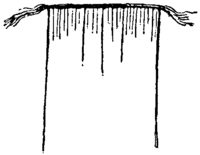of the onward movement, until it reaches the rounding plate, which is a block of steel with a polished groove a little larger than the size required. This rounding plate moves within a small arc by means of heavy counter-weights, and on the back of the book being strongly pressed against it, it receives the permanent form of the groove cut in it, at the same time a strong grip on each side of the book causes the ledge to rise up along each outer edge of the back. This ledge it is which enables the boards to be subsequently fixed in such a way as to hinge on a line outside the actual and natural boundary of the book. Before the discovery of the possibility of producing this ledge, the boards of books hinged upon a line coincident with the inner edges of the back, the result of which was that when the book was opened there was an invariable tendency to open and pull away the few outer sections of the paper or vellum itself—a destructive and disagreeable peculiarity. These machines are capable, after they are properly set, of rounding and backing about 750 volumes of the same size within an hour.

|

|
Fig. 10.—Section of back of book sewn on bands.
|
Fig. 11.—Section of same book after it has passed through the machine for rounding and backing.
|
The machine for making cases, or “case” covers (fig. 12), for books is large and complicated, but beautifully effective. It contains altogether over fifty springs, some of which are very small, like watch fittings, while others are large and powerful. The machine is fed with pieces of cardboard cut exactly to the sizes of the required boards, other pieces cut to the size of the back, and a long roll of the cloth with which the cases are to be covered, and when set working the roll of doth is gradually unwound and glued by contact with a roller, which is drawn along until it reaches a point where the two boards are ingeniously dropped upon it one by one, then on again to where a long arm swings backwards and forwards, at each movement picking up a piece of cardboard for the back and placing it gently exactly upon the glued bed left for it between the two boards already fixed. Next, as the cloth passes along, it comes under the sharp influence of two rectangular gouges which cut out the corners, the remaining side pieces being gradually but irresistibly turned up by hollow raisers and flattened down by small rollers, a very delicate piece of machinery finishing the corners in a masterly way. Then, lastly, an arrangement of raisers and rollers acting at right angles to the last mentioned turn over and press out the remaining pieces of cloth. Of course each piece of cloth is cut across at the proper point before the turning up begins. This machine is capable of producing 1200 cases in an hour of any size that the machine will take.
The Smyth casing-in machine (fig. 13) pastes the sides of a book as required and then attaches the cover over all. Cleverly arranged rollers catch the book, and by a carefully regulated pressure fix the cover in the proper position. There is a “jointing-in” device which at a critical moment forces the joints in the cover into the joints in the book. It will work books from 4 to 22 in. in length and from 14 to 3 in. in thickness, and can cover from 10 to 15 books per minute.
| A. | Cases. |
|
| B. | Side of Case Hopper. | |
| C. | Paste box. | |
| D. | Head Clamp Rod. | |
| E. | Head Clamp. |
Here may also be mentioned the Sheridan wrappering machine, which covers magazines and pamphlets ranging from 5 to 12 in. in length at the rate of 40 a minute.
Wiring is a cheap method of keeping together thin parts of periodicals or tracts. The machine that executes it is simple in construction


